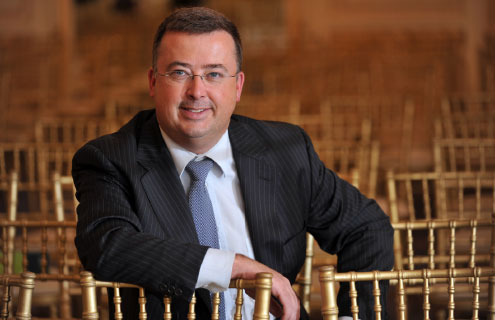IFIA
Pat Lardner
17 September 2014
A quarter of a century in the making, the hard work is still paying off for Dublin as a UCITS hub. Pat Lardner, CEO of the IFIA, explains why
 Image: Shutterstock
Image: Shutterstock
What are the key aspects that make Dublin a UCITS hub?
Since the first UCITS fund was launched in Ireland in 1989, we’ve seen tremendous growth—today Ireland is the home to UCITS fund assets fast approaching €1.2 trillion. The growth rate of our UCITS business has continuously been among the strongest, if not the strongest you’ll find—since the beginning of 2009 the annualised growth rate in UCITS funds domiciled here has been almost 13 percent per annum.
There’s a saying that success has many fathers and our tremendous growth has been due to a combination of things. As a country we’ve thrived with knowledge-based industries across sectors due to the quality of our people in terms of their technical ability, work ethic and dedication to nurturing deep relationships built around service excellence. So the quality of the raw materials that provide services to UCITS and other funds is absolutely world-class.
There are a number of other things that have been really important—clearly we are a great access point into the European markets and beyond. We also maintained and developed a regulated environment, which has demonstrated a commitment to openness, transparency and accessibility. Being regulated is a strength not a weakness and a clear, efficient and responsive regulatory environment has been a benefit. The cost and tax environment is also very competitive and this matters a great deal. Finally, the commitment from the government to grow the sector dates back to the inception of our industry.
It’s fair to say that throughout our journey over the last 25 years, the demands and complexities of the industry have increased and we’ve demonstrated an ability to develop and innovate—whether that’s in terms of automation or being able to support the widest possible range of strategies.
Our ability to draw from a young, well-educated workforce helps us to sustain and grow this business. Our ability to draw on the expertise that already exists within the industry locally helps us develop and maintain our position as a key location of the domicile and servicing of investment funds.
EFAMA reported a slow rise in UCITS funds for June 2014. Is there a slow down or are they still popular?
I wouldn’t read too much into one month’s data, irrespective of whether it is positive or negative. UCITS funds have and continue to be immensely popular, and from an Irish perspective, we’ve continued to see strong growth. In the six months to end June 2014, we’ve seen the value of our domiciled UCITS funds grow by more than 10 percent and this is a continuation of the longer-term numbers I mentioned above.
We are also seeing a combination of existing managers extending their ranges and new managers coming to recognise that UCITS is a vital enabler of their international distribution strategy.
With the Alternative Investment Fund Managers Directive (AIFMD) now in place, I do think there is a broader range of choices for managers that are looking at the specifics of their investment strategies and target investor base and thinking through the question of whether they should go the UCITS or AIFMD route. But overall I see it as positive for the industry.
How will UCITS V work alongside AIFMD and MiFID?
Given the more recent introduction of AIFMD and the pending implementation of UCITS V and the Markets in Financial Instruments Directive II, this remains somewhat of an open question.
We can say that the alignment of the UCITS depository environment to that of AIFMD, particularly in the context of eligibility and liability, will provide a more consistent approach to the provision of custody services to UCITS and alternative investment funds, and also ensure similar protections are available to investors in both fund types.
There are operational synergies between UCTIS management companies and alternative investment fund managers.
We have seen existing UCITS management companies become authorised as alternative investment fund managers—this dual licence is expressly provided for under AIFMD.
The acid test will be whether the existence of multiple rule-sets facilitates the effective delivery of a range of investment opportunities in a regulated format, which allow capital to flow into economies and maximises the potential for investors to meet their longer term needs.
Did UCITS V miss out any requirements? If so, will there be a UCITS VI?
Given that UCITS V was specifically aimed at introducing consistency with AIFMD for UCITS depositories, then I think it has achieved its initial objective.
The EU Commission published a UCITS VI consultation in July 2012 and while some of the proposals in this consultation paper are being pursued separately, eg, money market funds and European long-term investment funds, it’s clear that there is likely to be a UCITS VI—what remains to be seen is exactly what matters it seeks to address.
We believe that the focus of UCITS VI and the future evolution of UCITS should be to ensure that the protections in the UCITS framework in respect of risk management, liquidity management, organisational rules and internal audit, are fit for purpose. This should include the ongoing review of risk management provisions and continued evolution of requirements in relation to stress testing, back testing systems, reporting to the relevant regulatory authorities and provision of information to investors. Within such an investor protection-driven framework, there should be retained the greatest possible flexibility with regard to eligible assets.
Finally, the future development of UCITS should recognise the number of managers and investors from outside the EU that have embraced UCITS.
← Previous interview
Bank of America Merrill Lynch
Joanne Gill
Next interview →
Milestone Group
Paul Roberts
 Image: Shutterstock
Image: Shutterstock 